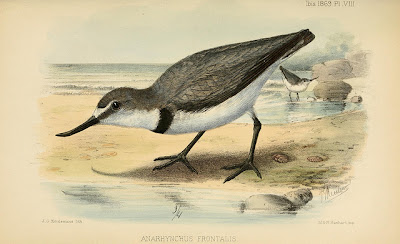Not-so-gratuitous picture: Ngutuparore (Wrybill) Anarhynchus frontalis.
Courtesy of the Biodiversity Heritage Library. Licence: CC: BY-SA-NC.
This week I had the pleasure of hanging out with an enthusiastic undergraduate entomologist who will be working with me over the summer. Lincoln University offers a number of promising undergraduate students employment over the summer, allowing them to gain experience of the research environment. Together, we've worked out a little research project that will involve him attempting to rear the larvae of Irenimus on artificial diets. This is something that I have been rather keen to give a go, but have been unable to devote the time needed to do it, so it will be very interesting to see how it goes.
The first obstacle that we've got to overcome is where to get the larvae. We will be attempting to get them using two methods. The first will be to keep adults in captivity, and hope that the females will eventually lay some eggs. The second will be to get into the field and start digging. This latter task sounds like a job for next week.
Courtesy of the Biodiversity Heritage Library. Licence: CC: BY-SA-NC.
Read:
McCulloch D. 2010. A History of Christianity: The First Three Thousand Years London: Penguin
Psalms 135–137 Websites:
University of Otago Marine Science—Coordinate transforms
OSGeo.org Nabble Forum—NZGD2000 to NZGD49
StackExchange—Calculate area of intersecting polygons in QGIS
StackExchange—Using R to calculate area of intersecting polygons
R-sig-Geo—Merging polygons
AntKey
Pirate Science—Meaningful clusters in trees
Science Daily—World's rarest whale seen for the first time
Watched:
Star Trek: Deep Space Nine Season 6

No comments:
Post a Comment